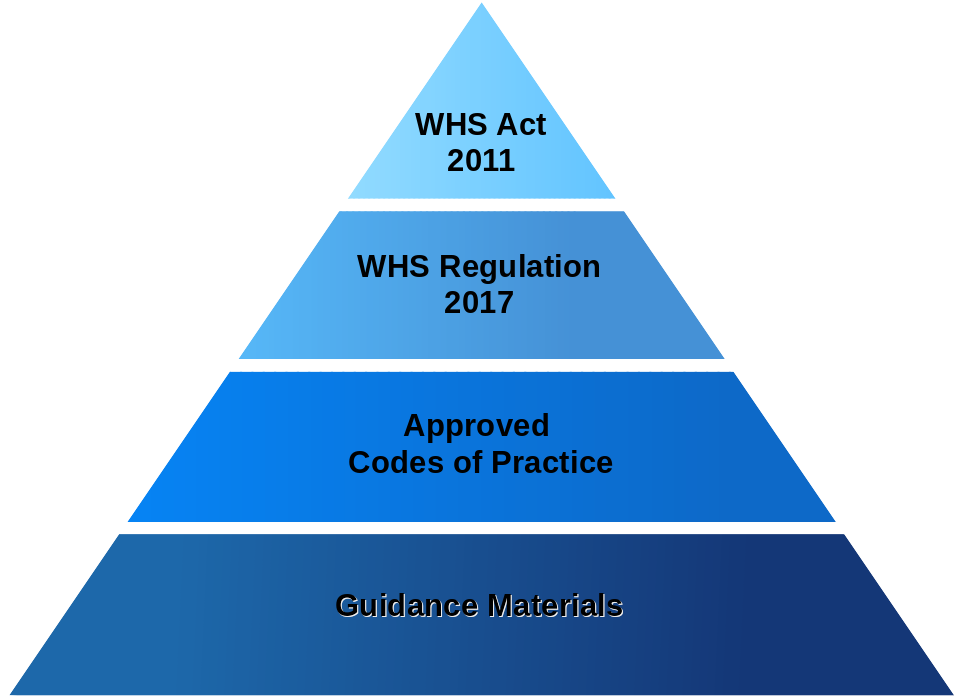WHS for Health and Safety Committees – NSW Edition
Lesson 1 – Topic 1: The Legal Framework
| Old Terminology | Current Terminology |
| OH&S | WHS (Work Health & Safety) |
| Employer | Person Conducting a Business or Undertaking (PCBU) |
| Employee | Worker |
| OHS Representative | Health & Safety Representative (HSR) |
| OHS Committee | Health & Safety Committee (HSC) |
| General Managers, Directors | Officers |
| Authorised Officers (Union Officials) | WHS entry permit holders |
Which documents make up “The Legal Framework”
WHS Act 2011
WHS Regulation 2017
Approved Codes of Practice
Guidance Material
Guidance materials include fact sheets, safety alerts and webpages produced by the regulators.
Australian/New Zealand Standards

- An Act (principal legislation) is a set of legal rules and duties, passed by parliament, that parties need to comply with and follow.
- A Regulation (subordinate legislation) contains many details to support the duties established in the Act.
- Approved Codes of Practice are best safety practice documents that assist duty holders to comply with the legislation. They are also admissible as evidence in legal proceedings
Codes of Practice are developed by Safe Work Australia in consultation with industry. Duty holders do not have to fully comply with a code of practice if they can achieve the same or better standard of safety in a different way.
- Guidance Materials are designed to assist duty holders to meet the requirements as set out in the legislation.
- Australian Standards are developed in consultation with industry and assist duty holders to meet their obligations.
If an Australian Standard is referred to in the legislation, then duty holders must fully comply with that Australian Standard. These Standards however, do not replace the duties and obligations imposed by the WHS Act and Regulation.
Objectives of the WHS Act 2011:
- Protect the health and safety of workers and other people by eliminating or minimising workplace risks;
- Ensure effective representation, consultation and cooperation in relation to health and safety issues in the workplace;
- Encourage unions and employer organisations to take a constructive role in improving health and safety practices;
- Promoting the provision of advice, information, education and training on health and safety; provide effective compliance and enforcement measures;
- Ensuring appropriate scrutiny and review of actions taken by persons exercising powers and functions under this Act
- Deliver continuous improvement and progressively higher standards of health and safety.
- Maintaining and strengthening the national harmonisation of work health and safety laws.
The guiding principle of the WHS Act is that all people are given the highest level of health and safety protection from hazards arising from work……
“so far as is reasonably practicable”.
So what is meant by “so far as is reasonably practicable”? It means weighing up matters such as:
- Likelihood of hazard or risk occurring. E.g: The likelihood of getting burned by an unlagged steampipe which is 20 metres up high is smaller than if this pipe was in the vicinity and in reach of workers.
- Degree of harm that might result. E.g: A small pinchpoint could cause a minor cut, an unguarded auger could cause amputation.
- What a person knows, or ought reasonably know, about hazards or risks and ways to eliminate or minimize these.
- For example: You hire a third party to do work for you. It is your understanding that this person will work by him/herself. However, this person now brings an apprentice along and does not let you know. Are you responsible for the safety of the apprentice?….YES you are because you ought to have known there was an additional person. HOW would you have known? … through sign in procedures, supervision, induction etc.
- Availability/Suitability of ways to eliminate or manage risks. E.g: Technology available overseas but not here or the control is insufficient
- After assessing the above, the cost of eliminating/managing hazards and risks. E.g: Can not afford. An organization needs to be able to prove that this is the case. If a preferred control is too costly, the PCBU must still control the risk through other means. Cost can never be an excuse to do nothing.
So as a minimum, these are issues that will be taken into account by a regulator or court,
in judging whether an action was reasonable and or practicable for a person to undertake or not.


